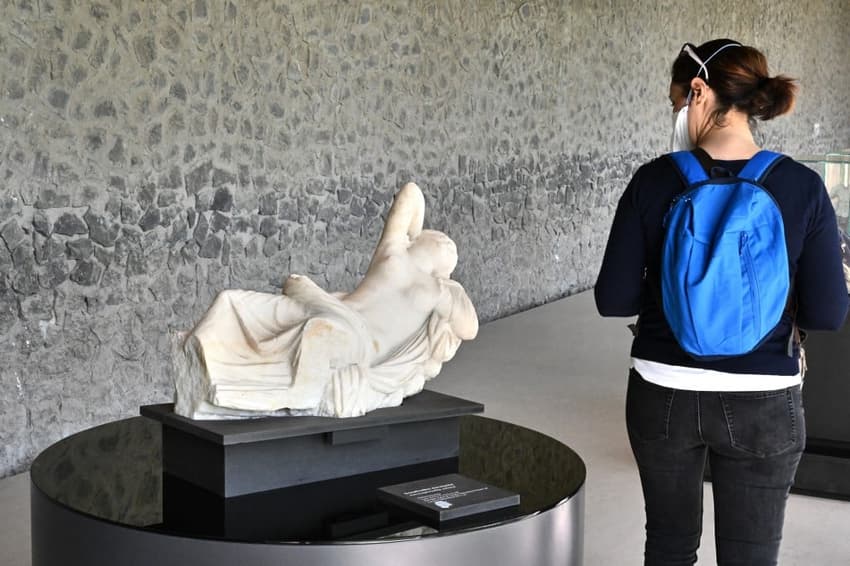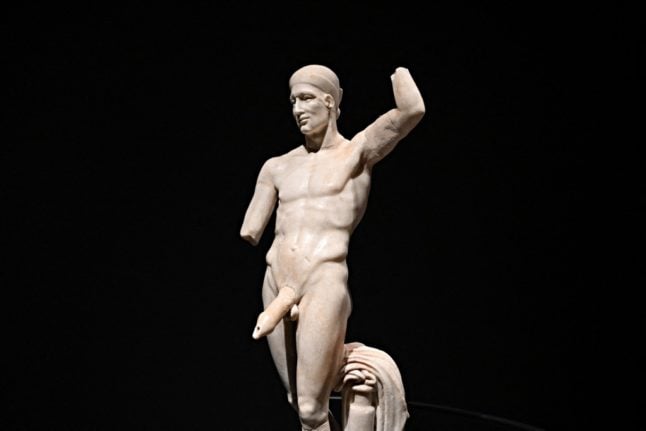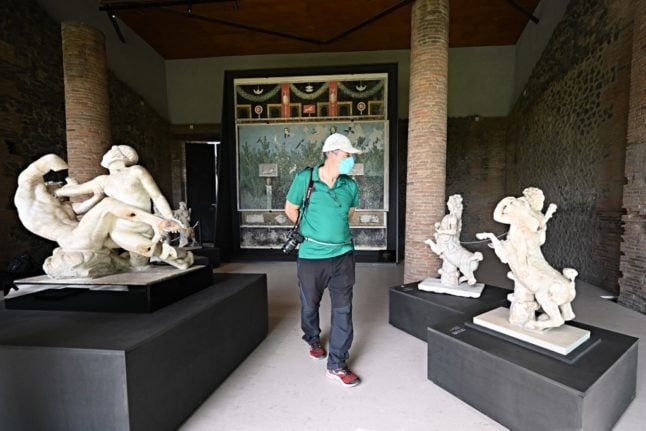Phallus of Pompeii: Italian art exhibition reveals ancient sexuality

Raunchy scenes may redden faces at a new exhibition in Pompeii on art and sexuality in the ancient Roman city, where sculptures and paintings of breasts and buttocks abound.
Archaeologists excavating the city, which was destroyed by the eruption of nearby Vesuvius in 79 AD, were initially startled to discover erotic images everywhere, from garden statues to ceiling frescos.
Since those first digs in the 18th-century site, racy images have been found in taverns, thermal baths and private homes, from huge erect penises to a statue with both male and female physical attributes.
READ ALSO: Roman chariot unearthed ‘almost intact’ near Pompeii
It became clear that "this is a city where sensuality, eroticism, are ever-present," Pompeii's site director Gabriel Zuchtriegel told AFP as he stood in front of statues of bare-chested Centaurs.
The discoveries initially caused "dismay, embarrassment, and curiosity, and were seen by some as a great opportunity to think about the relationship with their bodies and nudity in a very different way".

Pompeii's site director Gabriel Zuchtriegel, poses during a new exhibition in Pompeii's site entitled "Art and sensuality in the houses of Pompeii". (Photo by Andreas SOLARO / AFP)
The Neapolitan King Charles VII, who financed the excavations, shut some of the more bawdy finds away in a secret cabinet in Naples, only showing them to those of proven moral standing, Zuchtriegel said.
READ ALSO: Italian archaeologists uncover slave room at Pompeii in ‘rare’ find
That secret cabinet still exists today in the archaeological museum in the southern Italian city.
The exhibition, which runs until January 2023 and brings together some 70 works, begins with the vast erect penis on a statue of the god Priape - a Roman symbol of fertility and prosperity.

This photograph shows a "Statue-fountain of Priapus, symbol of prosperity" during a new exhibition in Pompeii's site entitled "Art and sensuality in the houses of Pompeii". (Photo by Andreas SOLARO / AFP)
Priape and his phallus was traditionally placed in the atrium, the large central hall of Roman houses.
Suitable for children?
Visitors are told this has nothing to do with eroticism, "though the modern imagination gives it this meaning", says Tiziana Rocco from the Pompeii exhibition office.
The smirking of embarrassed tourists is proof enough of that, despite some wishing it otherwise.
"I think modern American culture is a little bit too prudish, and uncomfortable with the human body," says Seattle tourist Daniel Berglund.
"It's nice to see ancient culture that was more open and willing to display and glorify the human body," the 40-year-old said as he lingered in front of paintings from a "cubiculum", or Roman bedroom.
Various scenes are shown, including a man and a woman having sex. Further on, a series of oil lamps shine light on images to make pulses race - though the curators have not forgotten that some people will be bringing their children to the exhibition.
"Families and children make up a large part of our public," says Zuchtriegel, who has put together an illustrated guide for them.
READ ALSO: IN PHOTOS: Pompeii’s treasures go on display at reopened Antiquarium museum
"The theme may seem difficult, but it is omnipresent in Pompeii, so it must be explained to children in one way or another," he said.
In the guide, a centaur - a creature from Greek mythology that is half man, half horse - searches for a mate.

A visitor walks during a new exhibition in Pompeii's site entitled "Art and sensuality in the houses of Pompeii. (Photo by Andreas SOLARO / AFP)
On the way he meets Narcissus, who fell in love with his own image, Dionysus, the god of wine, and Hermaphrodite, the child of Aphrodite and Hermes, who had both male and female sexual organs.
"It's a playful way to meet the different figures of Greek myths present in Pompeii," Zuchtriegel said
Comments
See Also
Archaeologists excavating the city, which was destroyed by the eruption of nearby Vesuvius in 79 AD, were initially startled to discover erotic images everywhere, from garden statues to ceiling frescos.
Since those first digs in the 18th-century site, racy images have been found in taverns, thermal baths and private homes, from huge erect penises to a statue with both male and female physical attributes.
READ ALSO: Roman chariot unearthed ‘almost intact’ near Pompeii
It became clear that "this is a city where sensuality, eroticism, are ever-present," Pompeii's site director Gabriel Zuchtriegel told AFP as he stood in front of statues of bare-chested Centaurs.
The discoveries initially caused "dismay, embarrassment, and curiosity, and were seen by some as a great opportunity to think about the relationship with their bodies and nudity in a very different way".

The Neapolitan King Charles VII, who financed the excavations, shut some of the more bawdy finds away in a secret cabinet in Naples, only showing them to those of proven moral standing, Zuchtriegel said.
READ ALSO: Italian archaeologists uncover slave room at Pompeii in ‘rare’ find
That secret cabinet still exists today in the archaeological museum in the southern Italian city.
The exhibition, which runs until January 2023 and brings together some 70 works, begins with the vast erect penis on a statue of the god Priape - a Roman symbol of fertility and prosperity.

Priape and his phallus was traditionally placed in the atrium, the large central hall of Roman houses.
Suitable for children?
Visitors are told this has nothing to do with eroticism, "though the modern imagination gives it this meaning", says Tiziana Rocco from the Pompeii exhibition office.
The smirking of embarrassed tourists is proof enough of that, despite some wishing it otherwise.
"I think modern American culture is a little bit too prudish, and uncomfortable with the human body," says Seattle tourist Daniel Berglund.
"It's nice to see ancient culture that was more open and willing to display and glorify the human body," the 40-year-old said as he lingered in front of paintings from a "cubiculum", or Roman bedroom.
Various scenes are shown, including a man and a woman having sex. Further on, a series of oil lamps shine light on images to make pulses race - though the curators have not forgotten that some people will be bringing their children to the exhibition.
"Families and children make up a large part of our public," says Zuchtriegel, who has put together an illustrated guide for them.
READ ALSO: IN PHOTOS: Pompeii’s treasures go on display at reopened Antiquarium museum
"The theme may seem difficult, but it is omnipresent in Pompeii, so it must be explained to children in one way or another," he said.
In the guide, a centaur - a creature from Greek mythology that is half man, half horse - searches for a mate.

On the way he meets Narcissus, who fell in love with his own image, Dionysus, the god of wine, and Hermaphrodite, the child of Aphrodite and Hermes, who had both male and female sexual organs.
"It's a playful way to meet the different figures of Greek myths present in Pompeii," Zuchtriegel said
Join the conversation in our comments section below. Share your own views and experience and if you have a question or suggestion for our journalists then email us at [email protected].
Please keep comments civil, constructive and on topic – and make sure to read our terms of use before getting involved.
Please log in here to leave a comment.